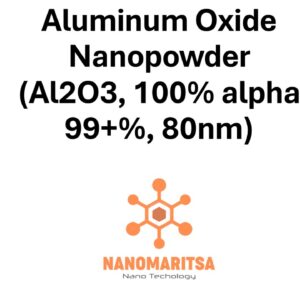Zinc Oxide Nanopowder Coated with 1wt% Silane (ZnO, 99+%, 20nm)
€220.00
CompareZinc oxide nanopowder coated with 1wt% silane (ZnO, 99+%, 20nm) is a specialized material that combines the properties of zinc oxide with enhanced surface functionality provided by the silane coating. The coating improves the powder’s dispersion, stability, and compatibility in various applications, making it suitable for diverse industrial, electronic, and biomedical uses.
Composition and Structure
ZnO (Zinc Oxide):
Zinc oxide is a binary compound consisting of zinc and oxygen, typically in a hexagonal wurtzite crystal structure. This material has remarkable properties such as a wide bandgap, piezoelectricity, and photoluminescence. ZnO is often used in electronics, optoelectronics, and as a catalyst or antimicrobial agent due to its versatile properties.
Purity (99+%):
With a high purity of 99+%, the nanopowder is nearly free from impurities, ensuring high performance and consistent behavior across various applications. This makes it suitable for sensitive and high-precision technologies, where material purity is critical.
Particle Size (20 nm):
The nanopowder has a particle size of approximately 20 nanometers, which provides a high surface area to volume ratio, enhancing its reactivity, surface interactions, and efficiency in applications like catalysis, coatings, and drug delivery systems.
Silane Coating (1wt%):
The addition of 1wt% silane to the ZnO nanopowder improves its surface characteristics, such as hydrophobicity, stability, and compatibility with organic materials. The silane coating acts as a coupling agent, allowing the nanopowder to bond better with other substances, making it easier to incorporate into composite materials or dispersions.
Properties
- Enhanced Dispersion and Stability:
The silane coating helps ZnO nanoparticles disperse more evenly in solvents, resins, and polymers. This reduces agglomeration, improving the material’s performance in applications where consistent particle distribution is crucial. - Improved Surface Functionalization:
The silane coating provides functional groups that can interact with various substrates, allowing for better adhesion and bonding in composite materials, coatings, and coatings for medical devices. This feature makes the nanopowder highly versatile and adaptable to different environments. - Antimicrobial and Photocatalytic Activity:
ZnO is known for its antimicrobial properties, and the coating does not interfere with its antibacterial or antifungal efficacy. The nanopowder remains effective in applications like personal care products, coatings, and environmental applications. Additionally, ZnO’s photocatalytic properties are preserved, making it valuable for pollutant degradation under UV light. - Enhanced Compatibility:
The silane coating improves the nanopowder’s compatibility with a wider range of organic polymers and solvents, making it particularly useful in composite materials for electronics, coatings, and advanced materials. It can also be employed in coatings for enhancing material durability and functionality.
Applications
1. Electronics and Optoelectronics:
Semiconductor Devices:
The enhanced dispersion and stability of the ZnO nanopowder make it ideal for use in semiconductor devices, such as light-emitting diodes (LEDs), photodetectors, and transistors. The silane coating improves the integration of ZnO into organic or polymer-based materials for flexible electronics and optoelectronics.
Thin-film Solar Cells:
ZnO-coated silane nanopowder is used in the development of thin-film solar cells. The improved dispersion of ZnO in the coating helps achieve higher efficiency and stability in these devices.
2. Coatings and Surface Treatments:
Antimicrobial Coatings:
Due to its antimicrobial properties, ZnO nanopowder coated with silane is used in coatings for textiles, medical devices, and household items. These coatings help prevent bacterial growth and maintain hygienic conditions.
UV-Blocking Coatings:
The silane-coated ZnO nanopowder is used in UV-blocking coatings for cosmetics, sunscreens, and protective coatings on plastics, glass, and fabrics. Its ability to absorb UV radiation effectively protects both materials and human skin from harmful sun exposure.
3. Environmental Applications:
Pollutant Degradation:
ZnO nanopowder coated with silane retains its photocatalytic properties, making it effective in environmental applications such as air and water purification. It breaks down harmful pollutants in the presence of UV light, improving the quality of both air and water.
Water Treatment:
ZnO-based photocatalysts are employed in water purification systems, where the silane coating enhances the interaction of the nanopowder with contaminants, making the degradation of organic pollutants more efficient under UV light.
4. Biomedical and Healthcare:
Drug Delivery Systems:
The high surface area and functionalization properties of the silane-coated ZnO nanopowder make it suitable for use in drug delivery systems. It can be used for targeted delivery of therapeutic agents to specific sites in the body, especially in cancer treatment and gene therapy.
Antimicrobial Textiles and Bandages:
The antimicrobial properties of ZnO, combined with the silane coating, make this nanopowder ideal for use in healthcare applications, such as antimicrobial textiles, wound dressings, and surgical bandages, where it can help prevent infections.
5. Research and Development:
ZnO nanopowder coated with silane is used extensively in nanotechnology research, particularly in the fields of nanocomposites, catalysis, and drug delivery. Its ability to interact with other materials and maintain stability under different conditions makes it a valuable material in the development of new technologies.
Safety and Handling
Health Considerations:
While zinc oxide is generally considered safe for many applications, it is important to handle nanopowders with care to prevent inhalation or direct contact with skin. Proper protective measures, such as wearing gloves, masks, and working in a well-ventilated area, are recommended during handling.
Environmental Impact:
The silane-coated ZnO nanopowder is typically considered to have low environmental toxicity, though research on the long-term effects of nanoparticle exposure is ongoing. Safe disposal and responsible use are important to minimize any potential environmental impact.
Summary
Zinc oxide nanopowder coated with 1wt% silane (ZnO, 99+%, 20nm) is a versatile and highly functional material with enhanced surface properties. Its combination of high purity, small particle size, and the silane coating allows for improved dispersion, stability, and compatibility in a wide range of applications. This material is widely used in electronics, coatings, environmental remediation, healthcare, and research, providing advanced solutions in diverse industries.
| Measurement (gr) | 100 grams, 500 grams, 1000 grams |
|---|






